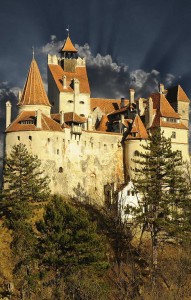Vlad Tepes, a.k.a. Vlad Dracul had NOTHING to do with Bran Castle as far as a residence… unless of course you count his two-month imprisonment. Perhaps he sent some minions to sack it at some point, history doesn’t say. The Bran lords were no fans of Vlad Tepes.
The castle became associated with the legend thanks to Bram Stoker, the author of the tale whose description of Dracula’s Transylvanian castle resembled it.
Bran Castle sits on the mountain overlooking a valley split by a river. While Stoker never set foot in Transylvania, he reportedly took inspiration from an illustration from Charles Boner’s book, Transylvania: It’s Product and It’s People, (London: Longman’s, 1865). *
The real Dracula or Vlad Dracul, held court in Wallachia from 1456-1462 and again in 1476. He was better known as Vlad the Impaler for his nasty habit of skewering folks on spears and leaving them “hung out to dry” in the sun. He was not someone you wanted to tick off… His castle is but a ruin these days.
Stoker published “Dracula” in 1897. Count Dracula’s name emerged from the Crusader Order of the Dragon. Both the real Vlad and his father were members of this organization. Transylvania’s people have spread myths and legends of ghosts, sorcerers, and vampires for centuries. This became the basis for the story. Stoker did not link his character to Vlad the Impaler. He did not wish people to believe his work to be historical.
Built by King Louis of Anjou in 1377, Bran fortress was perfectly positioned for a wide view of the surrounding area. The castle was not so much a military outpost as a trading one. It was one of the main trans-Carpathian passages for trade. Taxes were collected in the customs houses stand today at the base of the castle. Military invasions passed through en route to battle or decided to have their war on the premises.
German merchants from Brasov needed to pass through Bran to trade with Walachia. These merchants refused to obey trading laws set by Vlad. He attempted to set them straight through several altercations. One of these resulted in his incarceration, I presume.
Bran has changed hands over a few hundred years. It fell in disrepair when the border, and therefore, military routes changed. After the Russian-Turkish-Romanian War it was restored between 1833 and 1886. It wound up in the hands of the Brasov Forestry until 1918. **
Bran stands today, a grand reminder of medieval times. It’s beauty and presence is breathtaking. You can visit this glorious fortress. Bran holds various events throughout the year. For more information click on this link: http://www.bran-castle.com
*http://www.bran-castle.com/dracula.html
••http://www.bran-castle.com/medieval-fortress.html



